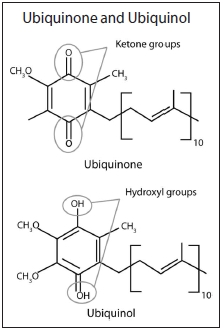
If you’ve browsed the vitamin/supplement aisle of your local natural products store, you may have noticed the strange bundle of letters and numbers, “CoQ10,” on some labels. Looking beyond its mysterious title, we discuss its benefits and the two forms in which it comes: ubiquinone and ubiquinol.
The Basics
CoQ10, formally known as coenzyme Q10, is an antioxidant that fights free radicals throughout the body. It helps form the molecule ATP (adenosine triphosphate), the energy source for all cells (1). Its versatility causes a natural boost to our immune system as well as host support to cells. Instead of attacking disease or chronic issues like modern medicines, it sustains cell life and strengthens them against the disease. Our bodies naturally produce CoQ10 in small quantities, but often these levels are too low and can be lowered even further by illness, age (which happens around 40) or other issues. With higher levels, CoQ10 can counteract free radicals’ effects, and this is where supplemental CoQ10 comes in.
It can be taken in a few different forms, such as soft-gel and hard-shell capsules, oral spray or tablets, and sometimes can be found in certain cosmetics or hair care products (1).The fat-soluble capsule is the most common and is recommended to be taken during a meal, the normal dosage being anywhere between 30 and 200 mg. Foods such as fish, meats and whole grains also contain small amounts of the antioxidant. For example, in a 3-oz serving of chicken or beef, the most CoQ10 that can be found is 2.6 mg (5). Given this amount, one should consider supplementation as a good way to get enough of this powerful antioxidant.
The Benefits
Although numerous studies have indicated CoQ10 as a good addition to our health overall, it cannot claim to heal serious health conditions, diseases or defects (1). It is best to consult a doctor or a healthcare provider when taking CoQ10, as it should not be used as a cure-all for any health condition.
Free radicals are as ominous as they sound. Particles in our bodies that come from a range of different sources often damage cells and inhibit their functions, and over time this could lead to serious diseases or chronic ailments (2). As mentioned before, the coenzyme promotes cell strength and immunity, and is able to travel all over the body to defend against harmful agents. Research linked to CoQ10 has produced positive results when the supplement was used in patients who had heart conditions, high blood pressure, diabetes, gum disease and cancer (1). The results CoQ10 produces are counteractive, in which people have shown signs of lowered blood pressure, reduced swelling in lungs, legs, and gums, increased male fertility and improvements in Parkinson’s disease symptoms (1). Beneficial reports also came from people who had heart attacks, blood clots and heart surgery. With an “optimal” diet of the right foods and prescribed medicines, CoQ10 has been found to help its consumers immensely (2).
Ubiquinone and Ubiquinol
If you’ve already looked into CoQ10, you might have heard about its two different forms. Though they seem like they would be the same (after all, there’s only a three letter difference), it is their chemistry that distinguishes one from the other. Ubiquinone and ubiquinol are two brothers of the same molecule, but in some cases, they have unique health benefits. CoQ10 is often synonymous with ubiquinone, a portmanteau of the words “ubiquitous” and “quinone” (2). Chemically, a quinone is part of a class of circular organic compounds containing two carbonyl groups. The body must convert supplemental ubiquinone to ubiquinol to be effective. Ubiquinol is often referred to as the “reduced” form of CoQ10. Some believe ubiquinol is more soluble and faster acting than ubiquinone, and therefore feel this form is best for those over 40 or who cannot effectively convert ubiquinone to ubiqunol in the body (4, 6). Supplemental ubiquinone, they believe, is best for those in their 20s and 30s to maintain good health. Despite the competitive research between the two forms, ubiquinone and ubiquinol are both effective. WF
References
1. University of Maryland Medical Center, “Coenzyme Q10,” www.umm.edu/altmed/articles/coenzyme-q10-000295.htm, accessed September 30, 2011.
2. Langsjoen, Peter H., http://faculty.washington.edu/ely/coenzq10.html, accessed September 30, 2011.
3. Encyclopedia Britannica, “Quinone,” www.britannica.com/EBchecked/
topic/487454/quinone, accessed September 30, 2011.
4. “Ubiquinol.” http://ubiquinol.org/coq10-ubiquinol-comparison, accessed September 30, 2011.
5. Linus Pauling Institute, “Coenzyme Q10,” http://lpi.oregonstate.edu/infocenter/othernuts/coq10/, accessed September 30, 2011.
6. Kaneka, “What Is Ubiquinol?: Ubiquinone vs. Ubiquinol,” www.kanekaqh.com/ubiquinone-vs-ubiquinol.html, accessed Oct. 13, 2011.










